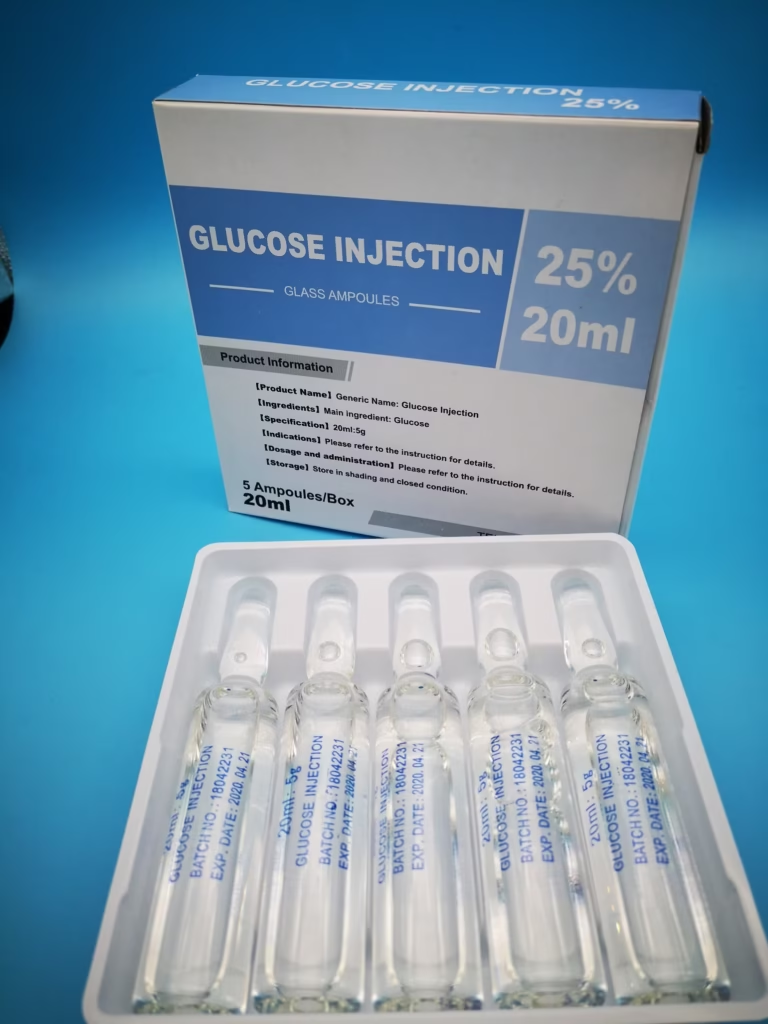🔹 Glucose Injection 25% – As Licensed
📄 Description:
Glucose Injection 25% is a hypertonic sterile solution of D-glucose in water, used for rapid correction of hypoglycemia and as a source of calories in patients unable to eat or absorb glucose orally. It is for intravenous use only.
💊 Prescription / Use:
- Indications:
- Severe hypoglycemia
- As a caloric supplement in patients with poor oral intake
- As part of parenteral nutrition
- Drug diluent in IV preparations
- Management of insulin overdose
- Dosage:
- Must be administered intravenously only
- Dosage depends on clinical condition, age, weight, and glucose levels
- Typical adult emergency dose: 25–50 mL (6.25–12.5 g of glucose)
- Route: Intravenous (IV) only
- Administration: Given slowly under medical supervision
🔬 Nature:
- Type: Hypertonic glucose solution
- Concentration: 25% w/v (25 grams of glucose in 100 mL of water)
- pH Range: 3.5 to 6.5
- Appearance: Clear, colorless or pale-yellow sterile solution
- Osmolarity: High; must be given with care to avoid vein damage
🌟 Advantages:
- Rapid correction of blood glucose in emergencies
- Immediate energy source for critically ill or fasting patients
- Can be combined with electrolytes or other nutrients
- Compatible with parenteral nutrition regimens
📦 Common Packaging:
- Ampoules or vials (25 mL, 50 mL, 100 mL)
- Glass or plastic bottles (up to 500 mL for infusion use)
- Each container labeled with concentration, batch no., expiry, and storage instructions
🧊 Storage:
- Store at room temperature (15°C to 25°C)
- Protect from light and freezing
- Use only if the solution is clear and free from particles
- Discard unused portion
⚠️ Precautions:
- Monitor blood glucose before and during infusion
- Use with caution in:
- Diabetic patients
- Renal impairment
- Thiamine deficiency (risk of Wernicke’s encephalopathy)
- Risk of:
- Hyperglycemia
- Electrolyte imbalance (especially hypokalemia)
- Phlebitis at injection site
- Fluid overload in cardiac or renal patients
- Contraindications:
- Hyperglycemia
- Intracranial or intraspinal hemorrhage (glucose may worsen cerebral edema)
👩⚕️ Patient Advice:
- For hospital or emergency setting only—not for self-use
- Inform healthcare provider of:
- Diabetes history
- Cardiac, renal, or hepatic conditions
- If prone to low blood sugar, carry oral glucose or sugar source
- Watch for signs of:
- Irritation or swelling at injection site
- Sudden thirst or frequent urination (possible hyperglycemia)
- Do not use at home unless instructed and trained by a medical professional

